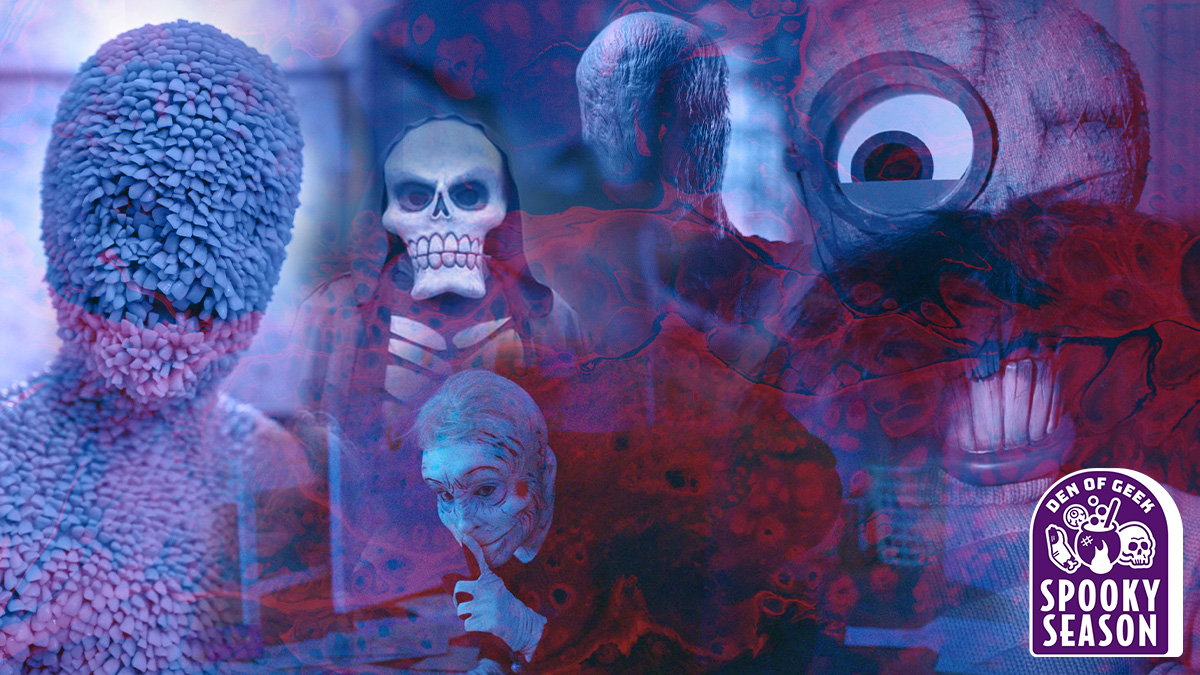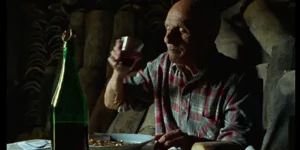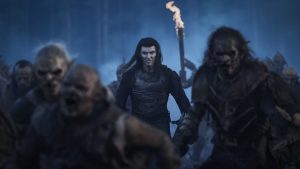
Cartoonist and writer Kris Straub remembers a prominent experience of child confusion and fear all thanks to televison.
“There’s a station in L.A., KLCS, that is public television, but back then it was like ‘Actual Public Television’s’ broke uncle,” he says. “They didn’t show modern stuff, only old filmstrips and educational shows from the 1970s. The production was so rudimentary to what we have today. I remember the weird trails that old magnetic video used to leave on moving objects, and puppets with wire loops for mouths, tugged open by strings.”
Straub recalls one filmstrip in particular, Inside Out, that was about 15 minutes long and offered up dramatizations designed to teach children various lessons.
“I now believe that it was intended for classroom use – to kick off discussions with a teacher – because the episodes tended to end in uncertain places,” he says. “A kid about to get beat up, an embarrassment in front of a class, a bicycle accident – and then the credits would roll. No resolution, just a dreamlike, half-remembered look at some uneasy choice or little misery.”
Straub turned that feeling of disorientation with media into a story on his website called “Candle Cove.” The story takes on the formatting of a series of posts on the television forum of a site called “NetNostalgia.” The original poster describes a bizarre program from his childhood named Candle Cove and other commenters chime in, discussing further and increasingly disturbing details.
It’s a fascinating and truly terrifying deconstruction of one of the internet’s favorite pastimes: remembering when. Candle Cove captures the feeling of when, instead of your best friend, the ’90s net was rabid dog ready to snap at you at any moment. The story was convincing and terrifying enough that Candle Cove was eventually adapted into the first season of Syfy’s Channel Zero.
Real life has always been a confusing, often horrifying experience for young people. The generations that grew up in the nascent days of the internet or without it at all spent years consuming media they didn’t always fully understand or confronting real-life mysteries they couldn’t quite contextualize. Now those generations have Wi-Fi, and they’re treating us to a renaissance in scary storytelling.
Technology has changed horror in some sophisticated ways. Those interested in visual horror need only to turn to YouTube channels like Marble Hornets to find a scary found footage series. The early 1900s radio play essentially made a comeback through horror podcasts like The Black Tapes and Limetown (the latter of which was adapted into a TV series).
But the real impact of the internet on horror has come in the form of good old-fashioned scary stories. Cyberspace is home to millions of scary stories that are being read by the glow of a computer screen rather than the crackling flames of a campfire.
The terminology for the phenomenon can be a little hard to nail down. In 2010, The New York Times ran an article on “creepypastas” comparing stories like that of Slender Man and The Russian Sleep Experiment to modern day chain letters. Creepypastas are scary stories or urban legends that get copy and pasted from forum to forum. The term comes from the original term for copy and pasted stories, “copypasta,” courtesy of (where else?) 4chan.
No one is in charge of policing such terms, obviously, but as nearest as it can be explained a creepypasta is something like Slender Man – a story that is destined, whether by design or fate, to become an urban legend. In the modern day, we don’t have to wait around hundreds of years for a relatively simple story to be corrupted into becoming something like a werewolf or vampire myth. We just need a well-told tale of a convincing and terrifying monster and then let it take hold.
Slender Man is an interesting case study in the power of creepypastas. Slender Man, the impossibly tall, faceless, and slender (of course) humanoid monster seen usually in a fine suit took the internet by storm. He’s ubiquitous and kind of an unofficial creepypasta mascot, going so far as to receive his own immensely forgettable feature film in 2018.
The power of such a myth is undeniable and in one instance had tragic consequences. In May 2014, two 12-year-old girls lured another girl into the woods and stabbed her 19 times, allegedly to impress Slender Man. Slender Man is clearly a fictional character with an easy Google-able creator, Something Awful forum user Eric Knudsen. Still, the “legend” proved stronger than the original story.
Even scary stories designed purely as fiction can be turned into creepypastas through the sheer shareability of everything on the modern internet.
“For better or worse though, the internet is amazing at not providing attribution to content,” Straub says. “So things can be spread in earnest, without any understanding on the part of the sharer or consumer where it came from. I never wanted Candle Cove to be a hoax – it’s an epistolary story in the format of forums. It had my name on it and all, but when people shared it, that all got stripped away. So as a creator I get bent out of shape about that – but as a consumer, I see the power that that had in letting the legend grow. People didn’t know if it was real or not. They still don’t.”
The vast majority of scary storytelling on the internet, however, doesn’t fall into that “creepypasta” myth-making category, whether it’s deliberate or otherwise. The most common category of scary story on the web has become a first-person, well-told yard designed to chill. If they’re not creeypastas, then what would the appropriate term for them be?
“I don’t think there’s a broadly accepted term but the term I use is campfire story,” says David Cummings, narrator of the The NoSleep Podcast.
The NoSleep Podcast is an audio spinoff of the popular reddit forum r/NoSleep. r/NoSleep has been up and running since the spring of 2010 and features thousands of first-person style scary stories.
Cummings, who began his career as a full-time musician in the ‘90s and has since transitioned into voiceover work, has been involved with the podcast version of the forum as a narrator since its inception. He began the podcast as a volunteer, but when no one else stepped in he assumed full-time narrator duties. He described the style of the internet “campfire story” thusly:
“A lot of the stories are really well-crafted and well-told, but they’re not necessarily literary. You don’t get these grandiose descriptions. They’re breatheless. ‘Oh my God, I just ran out of my friend’s house and I have to tell you what happened.’ There’s an immediacy and a believability.”
The goal of each story on the podcast and the subreddit is to be scary, personal, and above all else: believable.
There is a near fanatical devotion to the suspension of disbelief on r/NoSleep that has seemingly created the prototype for nearly all internet scary storytelling. Among the extensive rules and guidelines for the site is the phrase, “Suspension of disbelief is key here. Everything is true here, even if it’s not. Don’t be the jerk in the movie theater hee-hawing because monkeys don’t fly.”
“With the NoSleep sudreddit, there’s sort of this debate going on about are they real? Is this fiction? Does it matter?” Cummings says. “You still need to bring authenticity to the story even if it is fiction. I think a big part of it is people are…you need to hold their hand and lead them into a story and a setting they can relate to. If you start a story by ‘I was a sailor in a submarine and we were going in the Article Circle’…it’s harder for people to relate. I’m guessing the majority of people don’t really believe in ghosts or demons, but once they suspend disbelief they get there.”
This new NoSleep model of perpetual suspension of disbelief has, in many ways, replaced creepypasta mythmaking. After years and years of fine-tuning the art of the internet horror story, things seemed to have settled on the first-person campfire stories of old. The format has been producing compelling and unsettling content ever since.
For instance: one of the highest upvoted stories on r/NoSleep is the convincingly titled “My dead girlfriend keeps messaging me on Facebook. I’ve got the screenshots. I don’t know what to do.” Unsurprisingly, the story is about exactly that. Reddit user u/natesw chronicles his ongoing conversations with his dead girlfriend via Facebook chat. The story even concludes candid photos of natesw sitting at his computer purported to be taken by his dead girlfriend.
If easily suspended disbelief is a hallmark of modern internet scary storytelling, then it’s no wonder the story is so successful. There are virtually no cracks in the narrative that reveal it could be false…other than the truly impossible supernatural aspect of its narrative, of course. The account for natesw has remained silent for a decade and no one has stepped forward to claim authorship of the story. The narrative was even convincing enough to necessitate a Snopes page. Snopes, for its part, classifies it as “Legend.”
That’s the thing about these stories. By the inherent sharing capabilities of the Internet, any well-told first person narrative is capable of being classified a “Legend” by Snopes. And something about that is comforting – like anyone is a good story away from becoming a legend.
As evidenced by their increasing success, creepypastas/campfire stories/whatever-we-want-to-call-them in many ways represent the promise of the internet. The internet, as has been often observed, means the democratization of art and entertainment. As we’ve witnessed from many vapid YouTube videos or self-indulgent Facebook posts, however, not everyone has had something to say. Not everyone can succeed in dramatic or comedic arts.
But scary stories? We all have one. We all have that go-to legend or unexplainable personal experience in our back pocket for the next time there’s a campfire gathering. Now we don’t even need to wait for that.
The Best Creepypastas and Scary Stories
Here are some other stories from the creepypasta/internet campfire story genre to scare you half to death:
Ted the Caver – This is perhaps the oldest creepypastas, dating all the way back to an angelfire blog from 2001. The writer, Ted, details his exploration of a mysterious cave with his friend.
Squidward’s Suicide – Squidward’s Suicide is very low on the believability index but is appropriately chilling. It’s a first-person narrative from a person who purports to have once been an intern at Nickelodeon and discovers a lost episode of Spongebob Squarepants created by an unknown psychopath.
Jeff the Killer – Jeff the Killer is one of the few internet bogeyman remotely close in stature to Slender Man. The storytelling is somewhat weak and a clear gambit to create a legend. But the photo that always accompanies Jeff the Killer stories is synonymous with the concept of all creepypastas. There is even some Slender Man vs. Jeff the Killer fan art out there.
The Dionaea House – The Dionaea House is another early creepypasta, dating back to 2004, written by Eric Heisserer, who has actually found some success in the film industry since. That knowledge may ruin the verisimilitude of the story to a certain extent but it’s still profoundly creepy. And it’s written in the same epistolary format as many creepypastas are.
The Story of Her Holding an Orange – A lot of stories on r/NoSleep can have a bit of an ending problem…in that they don’t. The Story of Her Holding an Orange is similarly long-winded but at least it gets scarier as it goes along. It’s pretty terrifying in its simplicity.
(´・ω・`) – Ok, the full story’s title is actually “[Help!] The Girl I Like Won’t Respond to My Emails (´・ω・`)” but it’s more frequently identified as just the Prince-like symbol “(´・ω・`)” Of all the internet stories ever published, this would have my vote as most likely to be completely 100% real. The story originally appeared on Japanese forum 2channel in 2011 and features the increasingly desperate original poster asking for advice with his girlfriend “Denko.” The terror arises from the unnamed poster, who finishes every post with “(´・ω・`),” and seems to be the only person on the site who doesn’t realize he is a terrifying stalker.
The Showers – When describing the platonic ideal of what an internet campfire story should be, this is it. It might not be the best, but it exemplifies the format perfectly. The author regales a personal story about an abandoned haunted location that was told to him, then investigates it and provides the reader ample “updates” and photos. All the while, having a strong sense of narrative and what’s truly scary.
The post Beware the Creepypasta: Scary Storytelling in the Internet Age appeared first on Den of Geek.





